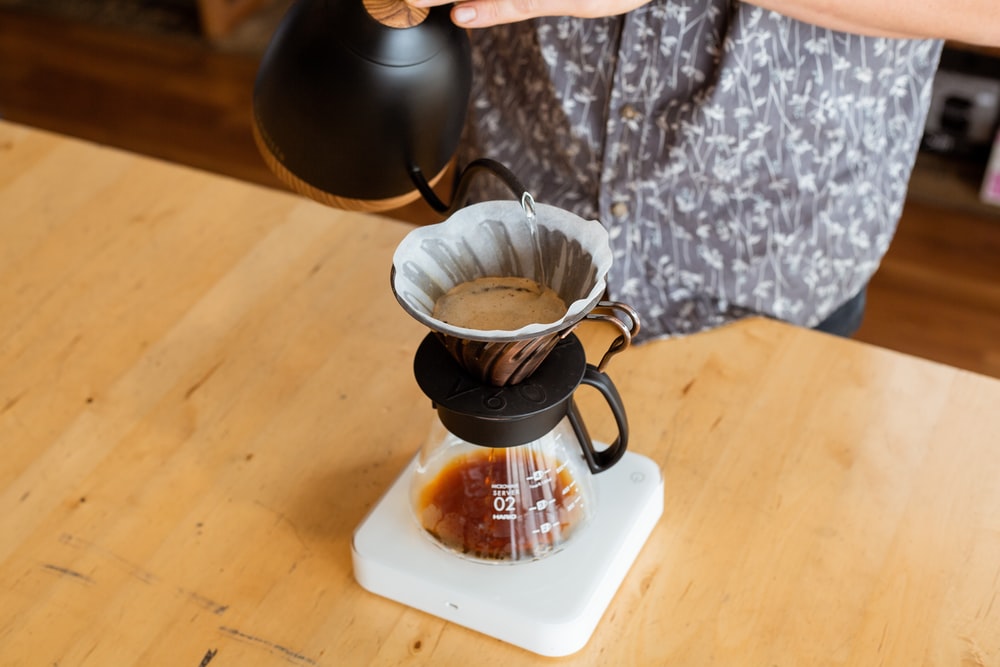Pour-overs offer more control over the coffee-making process than other methods. You can experiment with your ideal water temperature and grind size to find the perfect cup of coffee.
What are the benefits of pour-over coffee?
Coffee lovers who prefer black coffee often prefer the pour-over method because they believe it creates a more flavorful cup of coffee. Since the brewing process is longer, there is more time for flavor extraction. The slower the water filters through the grounds, the more flavor is extracted.
The pour-over method of brewing coffee is preferred by many enthusiasts because it allows for greater control over the taste, texture, temperature, and strength of the final product. This method also allows the user to control the temperature of the water and the speed at which it is added to the coffee grounds, as well as the total brewing time.
Pour-over coffee brewing can produce coffee that is much more delicious, rich, and balanced than regular auto-drip pots. Ripe flavors, a satisfying mouthfeel, and intense aromas are characteristic of pour-over coffee. The heart of the difference in coffee quality is in the mechanics of the brewer.
Is coffee that is brewed using the pour-over method weaker in terms of its caffeine content?
Pour-over coffee is brewed by pouring hot water over coffee grounds that are placed in a filter. This method continuously saturates the coffee grounds with fresh water for most of the brewing cycle, which makes the coffee brew faster and more efficiently.
To make pour-over coffee, you need to use a medium-coarse grind so that the coffee is extracted properly. If the grind is too fine, the coffee will be over-extracted and taste bitter. If the grind is too coarse, the coffee will be under-extracted and taste sour.
Pour-over coffees tend to have more flavor than regular drip coffees because the brewing process takes longer. This allows the water to pull the flavors and oils from the coffee grounds more effectively.
The pour-over method of brewing coffee results in a cup of coffee that tastes similar to drip coffee, which is preferred by some people. Additionally, the pour-over method is much easier to clean than the French press.
Is the pour-over brewing method superior to other methods?
Pour-over coffee is a superior form of coffee to drip coffee because it allows the coffee drinker to have more control over the taste of their coffee. This method usually results in a richer and more flavorful cup of coffee.
Starbucks is introducing pour-overs as a way for baristas to serve a quick, fresh cup of decaf or bold coffee. This will allow customers to have a hot cup of coffee without having to wait for a pot to be brewed.
To make coffee using the plunger method, start by pouring coffee grounds into the carafe. Add hot water and stir to make sure all the grounds are saturated. Wait four minutes, then put the lid on and slowly depress the plunger to isolate the grounds at the bottom of the carafe.
The ratio of water to coffee in espresso is about 2:1, while the ratio for pour-over coffee is 12:1 to 15:1.
Pour-over is a simple, inexpensive, and fun way to make the best-tasting coffee. The major benefit of pour-over is that, by controlling every variable, you can refine the flavor and body of the coffee to your tastes.
A single serving of espresso contains 40-75 mg of caffeine, while a single serving of pour-over coffee contains 80-185 mg of caffeine. This means that pour-over coffee contains twice as much caffeine as espresso, making it a great choice for getting your day started.
The European Journal of Preventive Cardiology found that filtering coffee is better for health than boiling ground coffee beans and drinking water. This is especially true for older people.
Why does my pour-over coffee taste watered down?
There are several reasons why coffee can taste watery, such as incorrect grind size or not enough coffee for brewing. To fix watery coffee, use the right grind size and amount of grinds for your brewing method, degauss your coffee beans for longer, check your coffee machine, or switch to a more intense roast.
A new study finds that filters remove heart-harming cholesterol from coffee, which significantly reduces your risk of dying from cardiovascular disease.
If you love your pour-over coffee like we do, you will need a medium-fine coffee grind size. This grind size is finer than sand, but not as fine as an espresso grind. This grind size is perfect for cone-shaped pour-over brewers (e.g. Hario v60, Kalita wave, etc).
The Towel Method: wrapping your glass French press in a thick kitchen towel will keep it warm while brewing. Alternatively, if you are looking to buy a new French press, consider one made of metal, as it will retain heat better than glass. Using a hot plate to keep your coffee warm can also work.
What temperature should water be for pour-over coffee?
The Clean Water Act protects our water supply from pollution. When making coffee, use clean water that you would drink. The water should be around 205 degrees or about 30 seconds off the boil. This will make the best-tasting coffee.
References
https://theroasterie.com/blogs/news/how-to-brew-the-perfect-pour-over-coffee-at-home
https://www.seriouseats.com/make-better-pourover-coffee-how-pourover-works-temperature-timing

